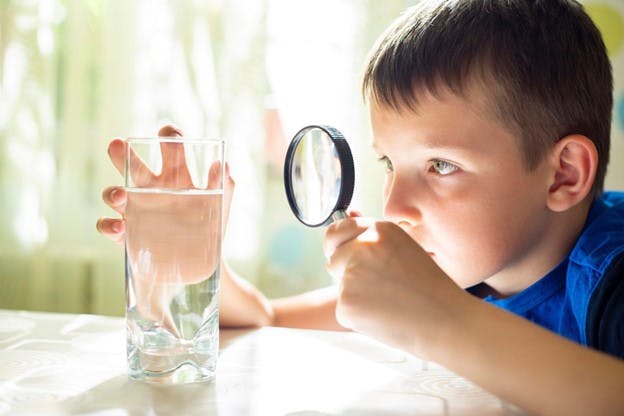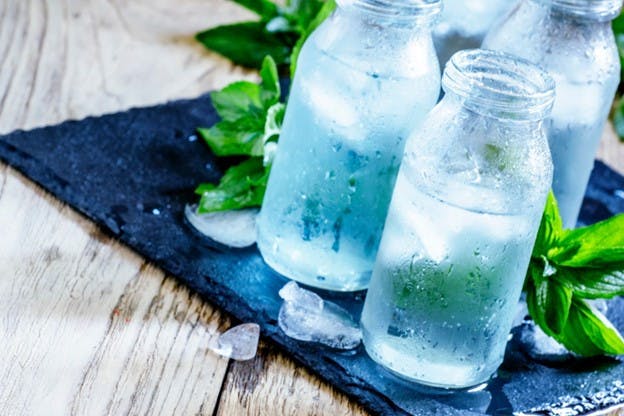🌟 New Arrival! Upgrade Your Water with Our Advanced Pitcher Filter. Shop Now
October 2023
Going Viral: Germs, Bacteria and Viruses in Water
Water is essential for all life on Earth. From creatures that view water as a refreshing drink to those that call it home, its importance can’t be overstated. Countless aquatic beings, ranging from the mind-blowingly large blue whale to microbiological creatures like bacteria and viruses, live their lives in watery habitats.
And while a whale has limitations in what water it can live in due to its size, bacteria and viruses can thrive unnoticed in an ocean, lake, swimming pool, or even your glass. This is a problem because some of these microorganisms can cause disease in people and pets.
In fact, bacteria and viruses in water have long been one of the largest health risks in human history. That’s why drinking water treatment has been such a win for public health. But even with modern disinfection techniques, it’s still possible for some pathogens to make it to your tap.
In this article, we’ll go over common bacteria and viruses in water. We’ll talk about the common pathogens found in water, the risks they present, and what to do to ensure you have safe drinking water.
What’s the Difference Between Bacteria and Viruses in Water?
Bacteria and viruses are not the same thing. There are differences in how they reproduce and the health effects they have on us. Let’s take a look at both to determine what bacteria and viruses in water mean to you.
Viruses
Viruses are infectious microbes that can only replicate by using the materials found inside a host's cells. As a virus infects healthy cells in order to find new building material for replication, the cells become damaged and often die. This can make the host organism sick, or worse.
There are many ways to classify viruses. One way is to group them by the primary system they target in the body. For example, one of the most common types found in water are called enteric viruses. These are known to take hold in the gastrointestinal tract, causing gastroenteritis. Rotaviruses, enteroviruses, norovirus, and poliovirus are well known enteric viruses.
Other virus types affect other body systems. For instance, influenza viruses and coronaviruses primarily affect the respiratory system. Enteric viruses usually enter water supplies through human feces and animal waste. This can be from wildlife or leaking sewage lines. Polluted storm runoff can also cause groundwater and surface water systems to become contaminated.
Viruses can infect a wide variety of hosts, including plants, animals, fungi, and even bacteria. Some well-known viruses that affect humans include the common cold, viral-meningitis, COVID-19, AIDS, and hepatitis A.
Bacteria
Bacteria are mostly simple, single-celled organisms found almost everywhere on Earth. Many types of bacteria are benign or even beneficial to people and animals, but some can make you sick.
Similar to viruses, bacteria can also damage host cells and tissues as they multiply, leading to illness. However, unlike viruses, bacteria can live and grow on their own without needing to invade a host cell.
In the context of waterborne diseases, common bacterial culprits include Escherichia coli (E. coli), coliform bacteria (more specifically fecal coliform), and salmonella. Other microorganisms like protozoa — cryptosporidium and giardia, for example — can also be responsible for waterborne illnesses.
Contaminated drinking water sources can lead to gastrointestinal issues like cramps and diarrhea. In some cases, bacteria like E. coli can cause more severe conditions like dysentery. Other bacteria, such as salmonella, can lead to serious illnesses including typhoid fever and even bacterial meningitis.
Are Viruses a Concern in Water?
Viruses can be a concern in drinking water, especially if you are using private well water that hasn’t gone through a treatment system. Modern treatment plants disinfect water using chlorine, chloramines, ozone, and ultraviolet light. This minimizes outbreaks of bacteria and viruses in water that can cause negative health effects in people and animals.
If you have public water, bacteria and viruses in water should be less of a concern but can’t be ruled out entirely. There have been several instances of waterborne disease outbreaks. The most notable is Flint, Michigan, which had a rash of Legionnaire disease between 2014 and 2016 caused by bacteria.
According to the U.S. Centers for Disease Control (CDC), 7.2 million Americans get sick from waterborne illnesses each year.
How Do You Treat Water Contaminated with Bacteria and Viruses?
Whether you have well water, you’re experiencing a boil water advisory, or you're outdoors with a questionable water supply, there are several ways you might be able to treat your water. Let’s discuss them along with the pros and cons of each.
Boil Water
Boiling water is one of the oldest methods for making water safe to drink. Humans have been doing it for thousands of years because it works. While some pathogens can survive in extreme conditions, there aren’t many that can survive being boiled for several minutes.
When you boil water, you want to get a rolling boil going for 3 minutes before letting it cool and drinking or cooking with it. Boiling water isn’t perfect, though. It takes a lot of energy to boil water and it doesn’t do much if you have chemical-contaminated water. Boiling water doesn’t get rid of chemicals, metals, or mineral solids. In fact, it can concentrate them as the water evaporates and leaves the sediment and chemicals behind.
Chemical Disinfectants
Since the 19th century, many public water distribution systems have used chemical disinfectants like chlorine and chloramines to disinfect their water. Many major cities like Montreal started using them after large outbreaks of waterborne disease.
Chemical disinfectants work through the inactivation of bacteria and viruses in water. That means it stops them from replicating. If a pathogen can’t replicate itself, it can’t make you sick. Chlorine has the advantage of requiring very little to be effective in treating water. It also evaporates out of water pretty quickly.
For chlorine to be effective, it requires prolonged contact with the water. Usually, 20-30 minutes will do the trick. If you ever find yourself in the middle of a boil water advisory and you can’t boil your water for whatever reason, you can treat your water with a small amount of household chlorine bleach instead.
Chlorine does have some disadvantages though. For one, it is a chemical and most of us would rather drink fewer chemicals. The taste and smell can also be quite off-putting for many people. Chlorine can also dry skin and hair when it’s in your shower water.
The biggest downside is that chlorine creates disinfection byproducts like trihalomethanes (TTHMs) when interacting with organic matter. While chlorine is safe to drink in small amounts, disinfection byproducts can cause health problems over time. Luckily, both chlorine and the disinfection byproducts it produces can be removed from water with a high-quality water filter.
Ultraviolet Light
Even before humans knew to boil water, the UV light from the sun was helping to keep us safe from bacteria and viruses in water. Just like the sun can damage your skin, it also damages pathogens and inactivates them without the use of harsh chemicals. Many public water suppliers opt to use UV light as their primary disinfectant while adding a little bit of chlorine as a secondary so it can make it through miles of pipes without being reinfected.
While UV light can be a powerful water disinfectant, it does have a few drawbacks. Mainly, any turbidity or floating sediment in the water can cover up bacteria and viruses. If the pathogens manage to stay in the shadows of debris in the water, it can move through unharmed and still make it to your glass.
The other weak point is that unlike with chemical contaminants which keep working for a while after they’re added, once water moves past the UV light, it's able to be contaminated again. For these reasons, UV light works better when combined with chemicals or filtration.
Filtration
Filtration is when water moves through a physical barrier that removes contaminants. There are many types of filters out there. Water can be filtered by going through sand, activated carbon, KDF media, or a reverse osmosis membrane.
Each method has advantages and disadvantages. Of all of them, a reverse osmosis filter is the best when it comes to viruses, protozoa, and bacteria. During reverse osmosis, water is forced through tiny holes in a membrane that don’t let anything but the water through. Most other water filtration methods struggle with very tiny microorganisms like viruses because they are small enough to slip through. Reverse osmosis filters are effective against bacteria, viruses, and so many other contaminants, like chemicals.
Using a high-quality reverse osmosis filter along with other methods discussed above can give you some of the highest quality water imaginable.
How to Test Your Water for Bacteria and Viruses
If you’re not sure about the quality of water coming from your tap, you can have water samples tested by a professional lab. If you have your own private well, you should be getting your water tested annually since conditions can change quickly and well water is unregulated. You should also make sure to get your water tested if you’ve recently had flooding or other contamination events.
For a list of professional labs and more information on water testing, check out this information from the CDC.
Keep Your Water Free of Bacteria and Viruses
Bacteria and viruses in water can cause a variety of waterborne illnesses in people and animals. That’s why you should always be mindful of the water you drink, even if it’s been treated by a public utility.
If you want nothing but the best water quality you can get, HomeWater can help. Our American-made HomeWater 4-Stage Reverse Osmosis Under Counter Water Filter makes sure you only get great-tasting water from your tap. It removes bacteria, viruses, cysts, sediment, dirt, chlorine, dissolved inorganics, barium, cadmium, hexavalent and trivalent, chromium, lead, copper, radium 226/228, selenium, fluoride, and nitrate/nitrite.
You’ll know the HomeWater difference from your first glass.
Related Articles
September 2023
Should I Use Filtered Water in My Baby Formula?
September 2023


